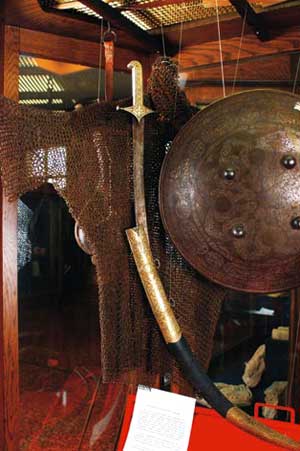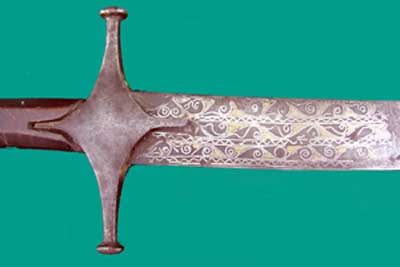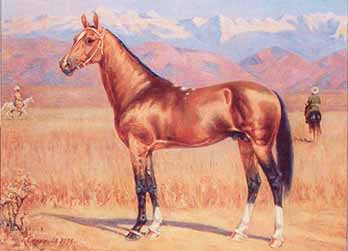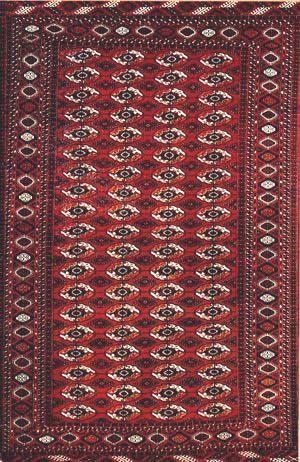Topic: Turkmen Traditions
 Swords
Swords Collectors and mere antiquaries of cold steel arms rarities always regard Turkmen arms with special tremble and respect. It is connected with the limited number of samples available in the private collections, as well as quick mentioning in literature. It left a particular print of mystique on Turkmen cold steel weapons. As it is known, the first appearance of sabre was directly linked with the formation of stirrups and hard saddle, the combination of which allowed only firm saddling but also striking chops. These changes activated some processes of development of arms, aimed at close fighting, which resulted in appearance of broadsword and later of sabre. The stable position on horseback gave a warrior a wide range of actions. The horsemen had an opportunity not only to lift on stirrups and sabre with stay, but also to lean back holding the rear arch or to release hands and ride using legs only.
The loss of weight of the sabre as compared to the heavy sword, which was attained at the expense of constriction of bar and elimination of the second blade, provided with wide possibilities for performing a wider variety of manoeuvres in close-in fighting.
Turkmen sabres are similar to each other. The blade of sabres are made of steel, they are forged, one-bladed, triangle in profile, and straight from the heel to one-third of their length, bending at razor-edge. It does not have refined cutting edges and dolls. The decorative design of the blade is practically absent. The sabre’s handle is formed by two steel bars, fastened at both sides with a wooden or bone hasp covered with leather and iron clinch. The teel caps of handles with clinches are located athwart towards the vertical arbour of handle. The reticles and crosses are straight and made of steel. The helves of blades are fixed with paste and passed with silver rope at the cross point. The length of blade of standard sabre in scabbard makes up 93-95 cm, the length of blade 76.5-83 cm, curvature 9.1-12 cm.
The Turkmen widely used sabres of local production in their military campaigns. I.V. Vitkevich, who traveled to Bukhara in 1830s, telling about the armament of Khiva warriors in his “Memoirs about the Bukhara Khanate”, notes: “Every soldier had a Turkmen or homemade sabre…”. The German researcher V.Konig writes in his monograph about the Ahal Turkmen of the Teke tribe, that local metalwork mainly consisted of making the simplest farming implements and cold steel arms, namely pikes, sabres and knifes. Many scholars denied the fact that Turkmen had self-made weapons. It should be mentioned, that along with domestic ones the Turkmen also used imported or captured cold steel arms. Nevertheless, sabres of local production had to meet the requirements to cold steel arms. Another important thing is that the elements of decorative design on Turkmen sabres and scabbards had its ethnic characteristics.
Cavalry swords and slightly crooked sabres, equally effective while striking stab cuts were not widely spread among the Turkmen. The sharp crook of the Turkmen sabre’s blade allows to consider it to be intended for cutting on horseback. The Turkmen arms are always objects of pride for its owner. The scabbard for cold steel arms may be considered and studied as a subject of independent decorative art. Their splendor and diversity amazes at first sight.
 Sabres’ scabbards can be wooden, covered with dyed leather, the lower part of its cover is fastened with a piece of leather, sewed on the backside, on the edges of scabbard, there is leather fringe. There are two metal girdles, to which brown leather shoulder belts are fastened. Scabbards are spirally twisted with the leather belt.
Sabres’ scabbards can be wooden, covered with dyed leather, the lower part of its cover is fastened with a piece of leather, sewed on the backside, on the edges of scabbard, there is leather fringe. There are two metal girdles, to which brown leather shoulder belts are fastened. Scabbards are spirally twisted with the leather belt. The Turkmen used to carry arms on the left side. The shoulder belts were crossed and fixed with a silver plaque or weaved. Such a belt was bestridden over the right shoulder, connected on the breast with a decorative bronze foundry clasp and two receivers made of analogous material. Moreover, one end of clasp was fixed, while another remained loose. The end of the clasp was made in the shape of bird’s head. As General N.I. Grodekov noted: “The Turkmen determine the origin of this or that individual to one or another tribe by the intangible differences in the way of fastening up a sabre…”
The belonging of a man to this or that social group may be judged from his arms, whose decorative design reflected the mightiness of its owner and his gentility. One should mention an unimpeachable taste, even delicacy of ancient masters while decorating Turkmen sabres, making each of them a unique piece of art.
The decorative design of Turkmen sabres can be conditionally divided into 4 categories.
The first category comprises applied silver stamped spearheads, decorating handles and scabbards as well as shoulder belts. Applied silver elements on the shoulder belts also belong to this group. Two types of applied plaques, round and heart-shaped, can be distinguished. According to the relief of its surface, the first type is subdivided into two variants – with the smooth face side and another side divided into bulbous sectors. The plates are presented with one type of rectangular shape.
The second category comprises ornaments of three types: stamped floral on one of the girdles, carved geometrical with the gilded background on one of the head-ends of the shoulder belt and S-shaped clasps as well as gilded floral ornament on the sabre’s handle.
The third group consists of embedding, decorating the head-end of the shoulder belt (red cornelian, turquoise) and S-shaped clasp of the shoulder belt (red glass).
The fourth group comprises the parts of sabres of decorative-and-practical purpose. In this case, fringe on the edges of the scabbard, as well as silver wire winding on the handles of sabres also belong to this category.
Aleksander KOSTENOK,
Ukraine
Photos from www.turkmenistan.gov.tm
Posted by countryturkmenistan
at 4:28 PM
Updated: Friday, 18 November 2005 4:31 PM

 15 July 2005. An inauguration ceremony of the National Museum of Ak Bugdai (white wheat) Wheat was held in the settlement of Anau, near Ashgabat, today.
15 July 2005. An inauguration ceremony of the National Museum of Ak Bugdai (white wheat) Wheat was held in the settlement of Anau, near Ashgabat, today. The Akhal-Teke horse breed (pronounced Ah-cull Tek-y) is a breed from Turkmenistan, where they are the national emblem. It is named after the nomadic tribe that bred them. They are racehorses, noted for their endurance on long marches and are thought to be the predecessors of the Arabian and English thoroughbred breeds. These beautiful "golden-horses' are adapted to severe climate conditions and are thought to be one of the oldest surviving horse breeds. There are currently about 3,500 Akhal-Tekes in the world, mostly in Turkmenistan and Russia, although they are also seen in Germany and the United States.
The Akhal-Teke horse breed (pronounced Ah-cull Tek-y) is a breed from Turkmenistan, where they are the national emblem. It is named after the nomadic tribe that bred them. They are racehorses, noted for their endurance on long marches and are thought to be the predecessors of the Arabian and English thoroughbred breeds. These beautiful "golden-horses' are adapted to severe climate conditions and are thought to be one of the oldest surviving horse breeds. There are currently about 3,500 Akhal-Tekes in the world, mostly in Turkmenistan and Russia, although they are also seen in Germany and the United States. Turkmen arts and crafts witnessed uneven development of various specialties. They had high esthetic and technical qualities, especially among herders. This included embroidery of clothing, especially wool leggings - jorab, purses and carpets.
Turkmen arts and crafts witnessed uneven development of various specialties. They had high esthetic and technical qualities, especially among herders. This included embroidery of clothing, especially wool leggings - jorab, purses and carpets.  Akgaima, kojime and ilme (or ildirme - chain stitching) are basic types of Turkmen embroidery stitches. Every stitch is widespread in certain groups of Turkmen. Akkaima is never met singly; sometimes it is combined with embroidery, which is made according to the technique of the second type - kodjp-me (or just keshde - embroidery), which is quite common on its own. Both akkaima and kojime are widespread amongst Turkmen - Tekins, Goklens, Sariks and other small groups living amongst them. Akkaima is mainly applied to men's tyubeteykas; this very stitch is also used for the neck of dresses and shirts, and the lower edges of women's trousers.
Akgaima, kojime and ilme (or ildirme - chain stitching) are basic types of Turkmen embroidery stitches. Every stitch is widespread in certain groups of Turkmen. Akkaima is never met singly; sometimes it is combined with embroidery, which is made according to the technique of the second type - kodjp-me (or just keshde - embroidery), which is quite common on its own. Both akkaima and kojime are widespread amongst Turkmen - Tekins, Goklens, Sariks and other small groups living amongst them. Akkaima is mainly applied to men's tyubeteykas; this very stitch is also used for the neck of dresses and shirts, and the lower edges of women's trousers.